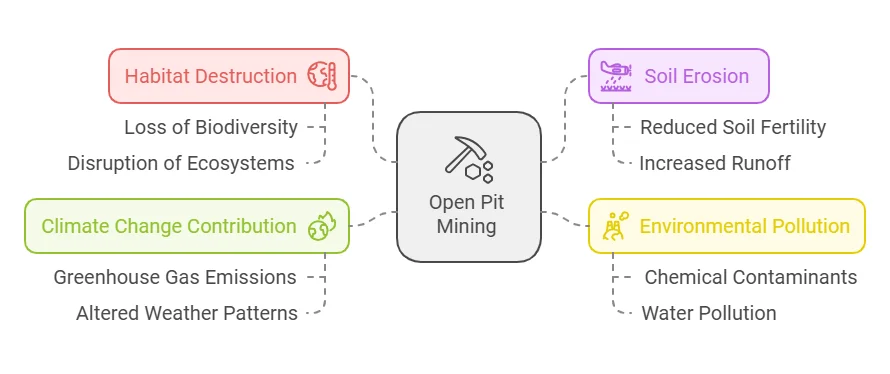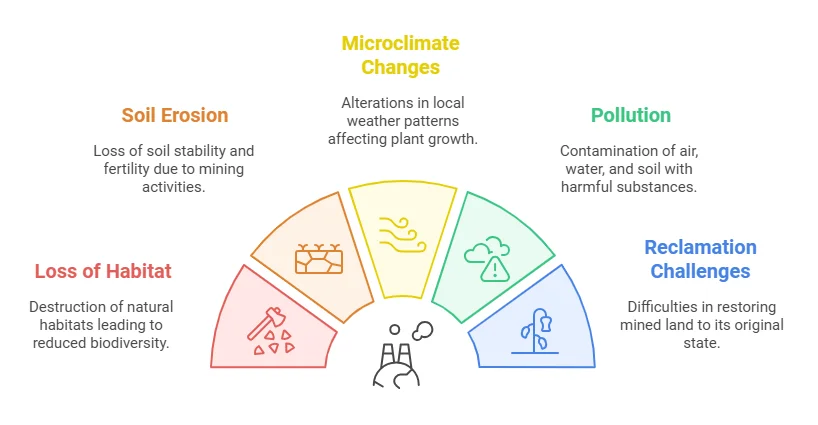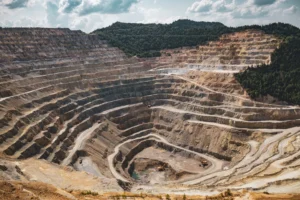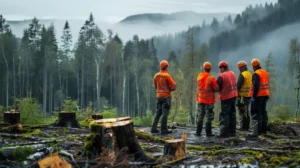Open pit mining, while economically advantageous, leaves a very deep scar, especially on plant life. As a surface method of mining, it often involves stripping off huge chunks of land to uncover minerals underneath.
The process doesn’t just disrupt soil but throws ecosystems out of balance while threatening the survival of those vegetation areas. Here’s a more detailed look at the major impacts of open pit mining on plant life.

What is the most likely consequence of open pit mining on plant life
Open pit mining significantly impacts plant life by destroying habitats, eroding soil, polluting the environment with chemicals, and contributing to climate change, all of which restrict plant growth and survival.

1. Loss of Habitat and Biodiversity
Destruction of habitats is one of the most visible and immediate consequences of open pit mining. Land for mining is usually cleared of all vegetation to prepare the site for excavation. The outcome is biodiversity decline and the total loss of plant life in the area, from towering trees to native shrubs and grasses.
- Surface mining often removes fertile topsoil, which is important for the growth of plants. In the absence of this layer, the land becomes barren and cannot support any vegetation.
- Some plant species, particularly those endemic to the region, may face extinction due to the loss of their habitats.
For instance, in areas that are particularly biodiverse, such as a tropical rainforest, the environmental degradation from open pit mining can be a chain reaction: the plants lost by mining also affect the loss of animals which rely on the plants for food and shelter.
2. Soil Erosion and Degradation
Plants serve as important soil fixers. The roots tie down the soil, eliminating the possibility of erosion as well as nutrient loss. Therefore, when vegetation is washed away during mining, the possibility of erosion increases significantly. This has far-reaching consequences:
- The transporting of the eroded, by-product-rich soil to nearby waterways causes siltation and devastates aquatic ecosystems.
- The stripped land loses its fertility, making it almost impossible for plant life to regenerate naturally without intervention.
This degradation of soil quality is one of the key challenges addressed during open pit mine reclamation, where efforts are made to restore the land’s ability to support vegetation.
3. Changes in Local Microclimates
Plants modify their local climate through shading, reduction of wind speeds, and soil moisture content. Removing massive portions of vegetation due to large-scale open pit mining interferes with these natural systems. Some of the impacts include:
- Soil temperatures are raised due to the absence of shade that prevents further growth of plants.
- Changes in humidity at local levels due to the loss of water vapor transpiration.
These changes can create a hostile environment for plants to thrive, extending the environmental impact of open pit mining far beyond the immediate confines of the mining area.
4. Mining Operations Pollution
Open pit mining uses chemicals and produces dust that causes damage to plant life. Dust from mining settles on the leaves of the plants, preventing sunlight penetration, which leads to low photosynthesis.
Furthermore, water runoff containing chemicals such as arsenic, cyanide, or heavy metals can leach into the surrounding soils, poisoning the plants and limiting further growth. This is one of the most significant concerns regarding the environmental impact of open pit mining.
5. Delayed or Incomplete Reclamation Efforts
While open pit mine reclamation is a standard procedure in many countries, mined land can take years, or even decades, to fully recover. Reclamation includes the reintroduction of native plant species, stabilization of soil, and restoration of ecosystems. But there are challenges:
- Non-native species, introduced during the reclamation process, might outcompete native plants, which could alter the ecosystem permanently.
- The soil, once damaged by strip mining and excavation, can be incapable of supporting new plant life, which can require great rehabilitation efforts.
6. Cumulative Impact on Nearby Plant Life
Even if the mining area is limited, the effects of surface mining can extend to nearby ecosystems. Dust, sediment runoff, and changes in water availability can stress surrounding plant life, reducing their ability to thrive.
For example:
- Deforestation for mining access roads divides habitats, making it harder for plants to spread and repopulate.
- Water sources diverted or contaminated by mining operations can deprive plants of the hydration they need to survive.
Conclusion
The environmental impact of open pit mining on plant life is significant and far-reaching. From the immediate loss of vegetation to long-term challenges such as soil degradation and pollution, the consequences demand attention. However, through innovative reclamation techniques and sustainable practices, the mining industry can reduce some of this damage.
Reclaiming mined lands is a responsibility. By prioritizing the reclamation of open pit mines and sustainable practices, we can help restore plant life and biodiversity for the future.




